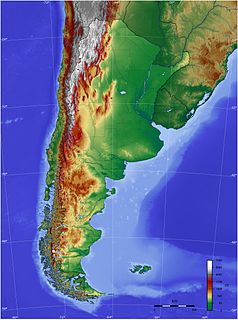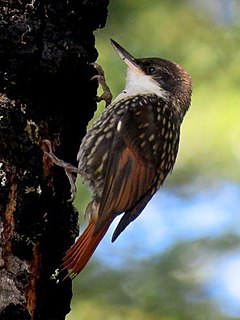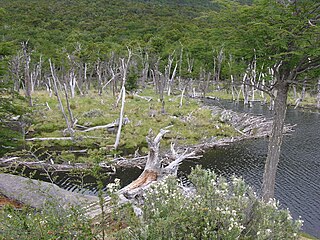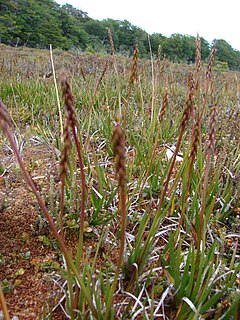
Tierra del Fuego is an archipelago off the southernmost tip of the South American mainland, across the Strait of Magellan. The archipelago consists of the main island, Isla Grande de Tierra del Fuego, with an area of 48,100 km2 (18,572 sq mi), and a group of many islands, including Cape Horn and Diego Ramírez Islands. Tierra del Fuego is divided between Chile and Argentina, with the latter controlling the eastern half of the main island and the former the western half plus the islands south of Beagle Channel and the southernmost islands. The southernmost extent of the archipelago is just north of latitude 56°S.

Patagonia refers to a geographical region that encompasses the southern end of South America, governed by Argentina and Chile. The region comprises the southern section of the Andes Mountains with lakes, fjords, temperate rainforests, and glaciers in the west and deserts, tablelands and steppes to the east. Patagonia is bounded by the Pacific Ocean on the west, the Atlantic Ocean to the east, and many bodies of water that connect them, such as the Strait of Magellan, the Beagle Channel, and the Drake Passage to the south.

The geography of Argentina describes the geographic features of Argentina, a country located in Southern South America. Bordered by the Andes in the west and the South Atlantic Ocean to the east, neighbouring countries are Chile to the west, Bolivia and Paraguay to the north, and Brazil and Uruguay to the northeast.

The Strait of Magellan, also called the Straits of Magellan, is a navigable sea route in southern Chile separating mainland South America to the north and Tierra del Fuego to the south. The strait is considered the most important natural passage between the Atlantic and Pacific oceans. It was discovered and first traversed by the Spanish expedition of Ferdinand Magellan in 1520, after whom it is named. Prior to this, the strait had been navigated by canoe-faring indigenous peoples including the Kawésqar.

Ushuaia is the capital of Tierra del Fuego, Antártida e Islas del Atlántico Sur Province, Argentina. With a population of nearly 75,000 and a location below the 54th parallel south latitude, Ushuaia claims the title of world's southernmost city. A much smaller municipality of less than 3,000 people, Puerto Williams in Chile, is nearer to the 55th parallel south, at a latitude of 54°56' S compared to Ushuaia at 54°48' S.

Tierra del Fuego, officially the Province of Tierra del Fuego, Antarctica and South Atlantic Islands, is the southernmost, smallest, and least populous Argentine province.

The South American gray fox, also known as the Patagonian fox, the chilla or the gray zorro, is a species of Lycalopex, the "false" foxes. It is endemic to the southern part of South America.
Omora Ethnobotanical Park is a protected area of Chile located 4 km (2 mi) west of Puerto Williams on Navarino Island in the extreme southern Magellan and Chilean Antarctica Region. The Omora Park is a research, education and conservation center for the Cape Horn Biosphere Reserve. The park itself includes a representative variety subantarctic flora open to the public for formal and information education. Within its boundaries, one can find deciduous forests and evergreen broadleaf forests, as well as bogs and high-Andean ecosystems and diverse mosses, lichens and liverworts.

The white-throated treerunner is a species of bird in the family Furnariidae. It is the only species in the genus Pygarrhichas. The white-throated treerunner is about 15 cm (5.9 in) long, with a stiff and rounded tail. The upperparts are dark brown, turning red on the lower back and tail and contrasting sharply with the throat and chest of a bright white. The rest of the underparts are coarsely mottled with white. The bill is long, slightly curved upwards. The general appearance is reminiscent of a nuthatch, although they are not directly related. Like the Sittidae, Furnariidae tirelessly scours the trunks and branches of old trees for the small arthropods that make up its food, spiraling up the trunks, or sometimes moving head down. The white-throated treerunner consumes small invertebrates found on bark and nests in tree cavities. Outside of the breeding season, it may form mixed-species foraging flocks with other bird species.

Ricardo Rozzi is a Chilean ecologist and philosopher who is professor at the University of North Texas (UNT) and the Universidad de Magallanes (UMAG). His research combines both disciplines through the study of the interrelations between the ways of knowing and inhabiting the natural world, proposing a dynamic continuous reciprocal feedback between both domains.
The Omora Sub-Antarctic Research Alliance (OSARA) is a U.S.-based non-profit, charitable organization dedicated to "exploring the biocultural wonders of the Tierra del Fuego Archipelago". This goal is accomplished by promoting research, education and conservation with the understanding that social well-being and biological and cultural conservation are inextricably linked.

"Ecotourism with a Hand Lens" is a term coined by Dr. Ricardo Rozzi and his colleagues to refer to a new speciality tourism being promoted in the Cape Horn Biosphere Reserve. Given the discovery of the archipelago's outstanding diversity of mosses, lichens and liverworts, Rozzi has called upon tourism operators to place this narrative into their offering for the region and take advantage of this biodiversity hotspot for non-vascular flora.

Reclus, also written as Reclús, is a volcano located in the Southern Patagonian Ice Field, Chile. Part of the Austral Volcanic Zone of the Andes, its summit rises 1,000 metres (3,300 ft) above sea level and is capped by a crater about 1 kilometre (0.62 mi) wide. Close to the volcano lies the Amalia Glacier, which is actively eroding Reclus.

Tierra del Fuego National Park is a national park on the Argentine part of the island of Tierra del Fuego, within Tierra del Fuego Province in the ecoregion of Patagonic Forest and Altos Andes, a part of the subantarctic forest. Established on 15 October 1960 under the Law 15.554 and expanded in 1966, it was the first shoreline national park to be established in Argentina.

The governments of Chile and Argentina are attempting to eradicate the North American beaver in the Tierra del Fuego area at the southernmost tip of South America. This non-native species was introduced in 1946 as a potential source of commercial fur trading. When the fur trade industry was unsuccessful, however, the beavers became problematic and the governments agreed to intervene. A June 2011 NPR report stated that the beavers have caused millions of dollars in damages. According to Nature, this plan is the largest eradication project ever attempted.

Tetroncium is a genus of plants in the Juncaginaceae described as a genus in 1808. It contains only one known species, Tetroncium magellanicum, known from a few sub-Antarctic islands: Tierra Del Fuego, Falkland Islands, and Gough Island. The plant got the name magellanicum because the original description was describing the sample found near the Strait of Magellan.
Tobífera Formation is a volcano-sedimentary formation of Middle to Late Jurassic age. The formation is crops out in the Magallanes Region in southern Patagonia and Tierra del Fuego of Chile, the Santa Cruz Province of southern Argentina, and in the subsurface of the Malvinas Basin offshore Argentina and the Falkland Islands.
Fueguino is a volcanic field in Chile. The southernmost volcano in the Andes, it lies on Tierra del Fuego's Cook Island and also extends over nearby Londonderry Island. The field is formed by lava domes, pyroclastic cones, and a crater lake.

The Patagonian grasslands (NT0804) is an ecoregion in the south of Chile, Argentina and the Falkland Islands. The grasslands are home to diverse fauna, including several rare or endemic species of birds. There are few protected areas. The grasslands are threatened by overgrazing by sheep, which supply high-quality merino wool. Efforts are being made to develop sustainable grazing practices to avoid desertification.

The North American Beaver is an invasive species in the southern tip of Patagonia, an area called Tierra del Fuego. Tierra del Fuego is a large island and encompasses land belonging to both Chile and Argentina, and as such, policies and actions to control and eradicate the species has mostly been binational. The beavers were introduced to the area in 1946 due to an effort by the Argentine government to establish a fur trade in the region. Ever since the introduction event, the beavers have spread throughout most of Tierra del Fuego and have even been recently spotted on the Brunswick Peninsula, mainland Chile.














